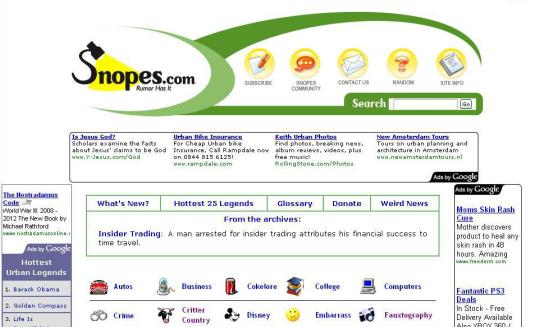One of my pet peeves related to the Internet is the amount of inaccurate information you can get.
That the Internet is technically infinite, and costs virtually nothing for anyone to write and upload whatever they want, makes it fertile ground for falsehoods to fester — whether by malice, accident or ignorance.
For the longest time, before blogging and social media became buzzwords, it was forwarded e-mail that got to me. What bugged me more than the junk mail was the people who were blindly forwarding them.
Technology should not be blamed, though. Granted, the Internet is an efficient avenue to get information out there. E-mail can be written and delivered in minutes, and now social media gets things going in mere seconds.
However, I feel that it is the perpetrators — whether it is the original creator of the message, or the people helping to spread the news — who should carry the burden of blame.
Nowadays, with social media being so heavily utilised, the rate that information is being generated and spread is even faster.
Here are a few tips Internet users can adopt to help minimise the spread of misinformation:
1. Read carefully before you tweet
A tweet is fewer than 140 words, so read it carefully before you retweet.
Just last week, local actor and playwright Jit Murad updated his Facebook profile status laughing off rumours of his death. According to him, someone had tweeted: ”Jit Murad just passed by” and someone else read that Tweet as ”passed on”. This was also the case when the late Yasmin Ahmad ”passed out” during a meeting (which eventually led to her actual death).
This is of course not Twitter specific as it can happen also via e-mail, SMS, Facebook and blogs, for example.
2. Check your facts
It’s not gospel truth, just because it is in written form. Often, we blindly send email we receive to people in our address book because we assume that everything we read is fact. A good way to overcome this is to use a little bit of common sense and spend some time fact checking.
For example, if something sounds off or strange, don’t assume that this ”novelty” is the reason why the e-mail exists in the first place. It could just very well be a prank.
One easy way of getting around this is by doing a Google search. You can usually find more information on it (sometimes, pranks are busted really quick that it will even show on your search). Otherwise, there are some sites that specialise in demystifying facts such as www.snopes.com or www.truthorfiction.com.
3. Check your sources
With incidents which are closer to home, you can also check your sources. For example, during the unfortunate church attacks last week in the country, there were several rumours floating around the Internet.
Due to conflicting reports, some twitterers actually contacted the police to double check certain claims that were being made. This served two purposes: One, that they could check for accuracy of the claims, and also that checking could help correct any erroneous information.
4. Follow voices of authority
The wonder of social media is it helps people communicate directly with the masses. Many public personalities — whether politicians, artistes or activists — have taken to the Internet to speak to their followers and fans direct. A good way to ensure that your information comes from the horse’s mouth is by, er, following the horse.
5. Use common sense
There is no underestimating good old common sense. Access the situation and what you read. If it seems dubious, check up on it. If you are not able to verify it, hang on to the information first and pass it on only if you can confirm its accuracy.
With so much information available out there, just remember to approach everything with a pinch of salt. Often, there is no malice involved but things do get lost in translation, so it never hurts to be careful!


Leave a reply